Personal Daemons
Ian Cheng’s personality test for NFT collectors connects the impulses toward speculation and introspection.
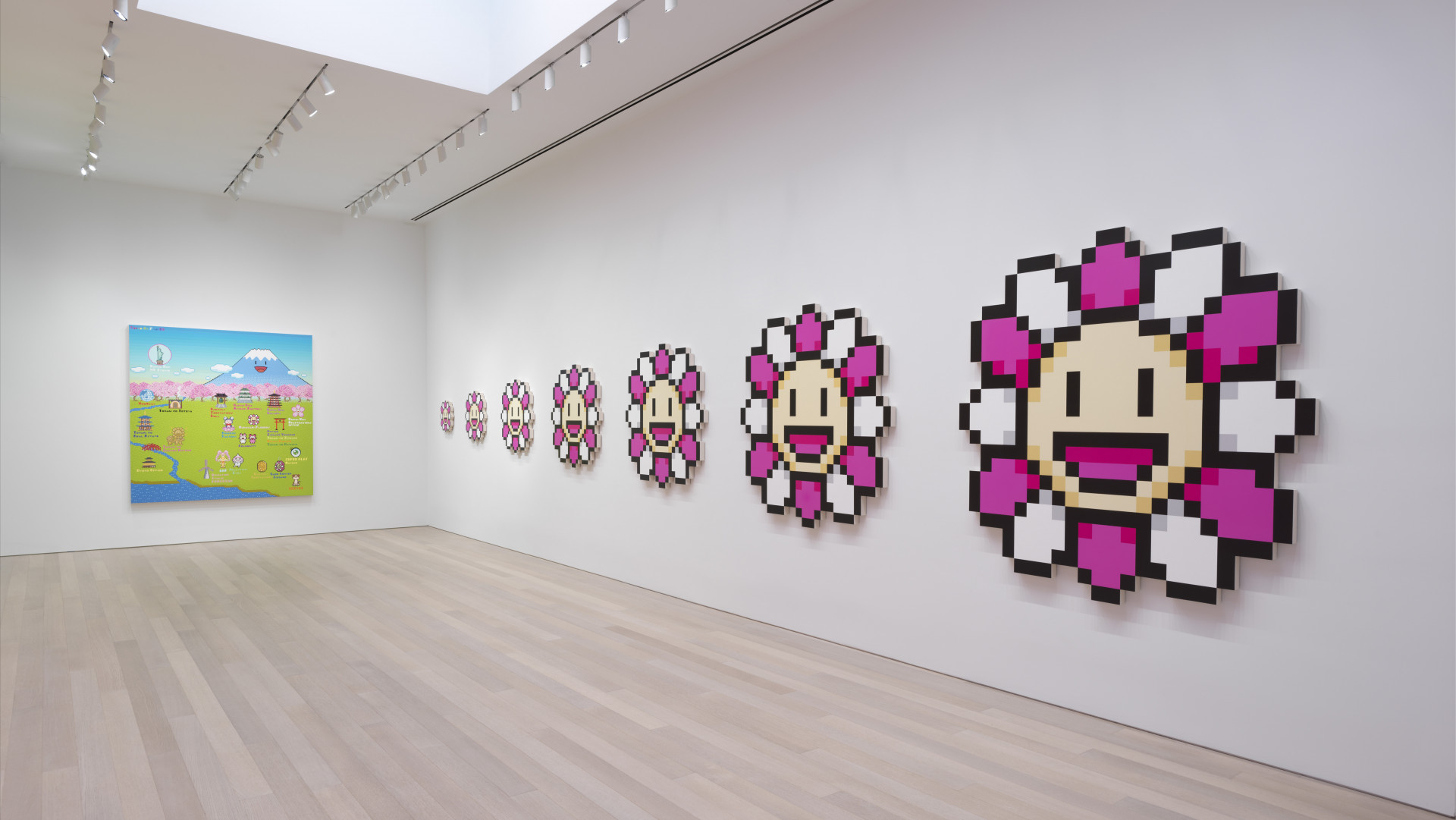

In the virtual version of “An Arrow through History,” Takashi Murakami’s new exhibition at Gagosian Gallery in New York, the doors are locked. There are no gallery attendants to walk by awkwardly, but the architectural details are all there: the bleached wood floors, the hot white puck lights, and the gallery home page loaded on the iMacs. It was unclear what time it was when I beamed in, other than perhaps time to buy something (a button at the top right beckons you to “Connect Wallet”). It was like entering a nightclub during off-hours: whatever was supposed to happen had already happened, or was yet to happen; I was either too late or too early.
I visited this virtual space multiple times over the last few days on my computer and on my phone, before and after seeing the exhibition in person, and every time it left me feeling somewhat hollow. The exhibition’s physical counterpart spans Gagosian’s two locations on Madison Avenue, and it consists primarily of sculptures and paintings, but these objects are tied to the metaverse in a variety of ways. Many of the paintings are exacting re-creations of their corresponding NFTs, and look almost identical to their online versions. Rather than bringing the physicality of the real world into the digital, Murakami brings the deadened, 2D nature of digital images into physical space. In an interview for Gagosian Quarterly, Murakami predicts a “cognitive revolution.” “Right now we still fuss about whether a product is corporeal, and whether or not we can touch it with our fingers and bodies, but that will soon be a nonissue in the reality of the metaverse,” he says. What future for art does this primarily visual, disembodied experience foretell? Will the revolution leave my body behind?
Rather than bringing the physicality of the real world into the digital, Murakami brings the deadened, 2D nature of digital images into physical space.
Murakami attributes his awakening to the “metaverse” to the pandemic summer of 2020, when his children started playing Animal Crossing: New Horizons. In the aforementioned interview, he describes watching his children’s avatars gaze up at fireworks in the night sky, chop down trees, and decorate their homes with their friends. It inspired him to develop a Tamagotchi-style game, and explore how video games and emerging technologies might reshape the contemporary art world.
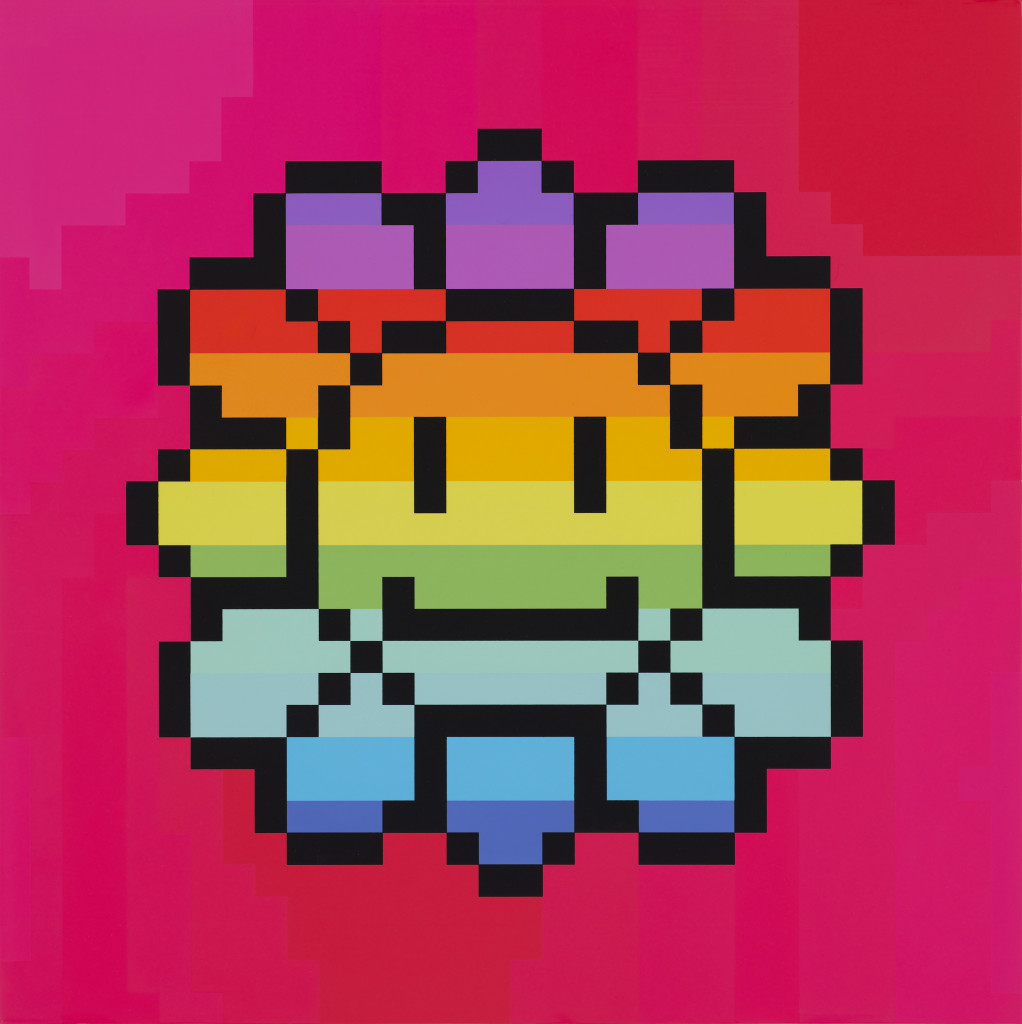
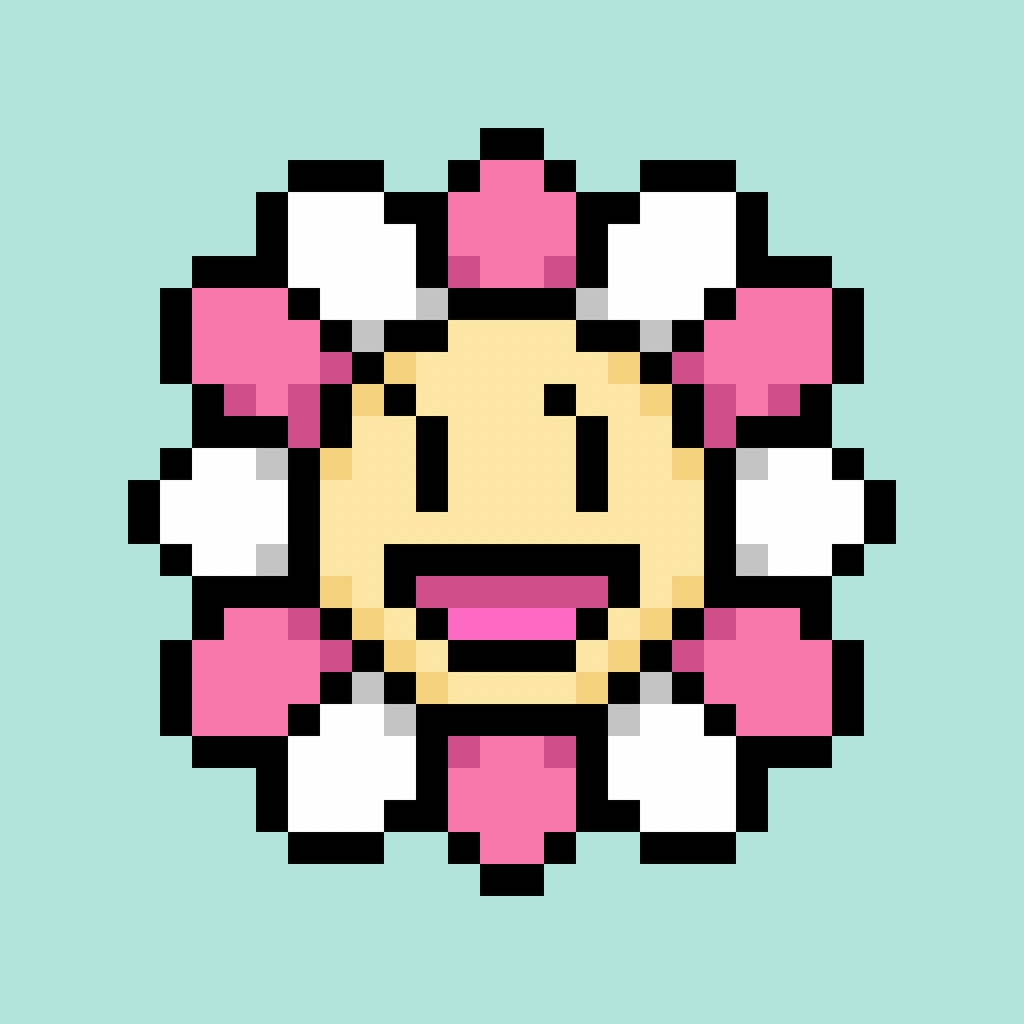

Each time I entered the metaverse, I was given a different nine digit identifying code. This time it was 02EYat01Q. My avatar was a small coin—a smiling, pixelated daisy, with alternating pink and white petals on a light blue background. It shares a motif with the 11,664 NFTs being released this spring as Murakami.Flowers; each one is a 24-by-24 pixel drawing, a nostalgic throwback to 1980s gaming consoles.
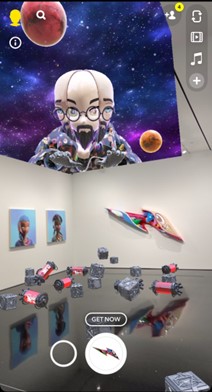
My floating coin moved soundlessly across the wooden gallery floors until it encountered the sixth-floor gallery, full of round, blue-and-white fish paintings inspired by thirteenth-century Chinese porcelain. This is the first of three projects on view in this show, and it seeks to connect the technological advances of Qinghua ceramics to the NFTs of now. But the digital context overwhelms them. Despite the painstaking handiwork, the paintings look cold and serially produced. Gagosian’s physical galleries boast surprisingly fun Snapchat filters that overlay live animations onto the art and the floor when viewed through the app. In the fish room, these submerged the gallery underwater. Oddly, these lively settings are not available in the exhibitions’ virtual counterparts, which seems like a lost opportunity. It could have been crazy!
My modest proposition is that “An Arrow through History” is actually a show of photography, not painting. Although all the objects are painted, their flat pixelation anticipates their eventual retranslation back into digital space. More striking, though, was how my coin avatar mirrored the artwork. We were both just virtual renderings, except one was very expensive. I felt, temporarily, like a unit of currency rather than a human being. I oriented my avatar to face one of the paintings, Chinese Perch after Kitaoji (2022). I felt my sense of disembodiment captured by the fish in the painting: pursed lips turned to the surface of the 2D water, frozen and breathless. Is this a condition of art in the metaverse—that I, the human being, am indistinguishable from the work I am viewing? Virtual viewership resolves the mind/body split by flattening everything through mediation: mind is body is code.
Although all the objects are painted, their flat pixelation anticipates their eventual retranslation back into digital space.
This equivalency of digital selfhood and digital artwork, and the financialization of that dynamic, is the intriguing and troubling crux of this show. As I followed my coin down the stairs into the fifth-floor gallery, my malaise was reinforced by a room of my doppelgangers: a wall of 108 variations on the daisy avatar, drawn directly from Murakami.Flowers. One smirks, another smiles flatly. One looks frightened and another sad. The same gallery has a larger, 5-by-25 grid of more detailed daisy avatars, whose level of personal expression made my avatar feel plain and unadorned. There was a starstruck daisy with sparkles for eyes and a drooling mouth, a daisy wearing a headband. The specifics mattered less than the illusion of endless uniqueness.
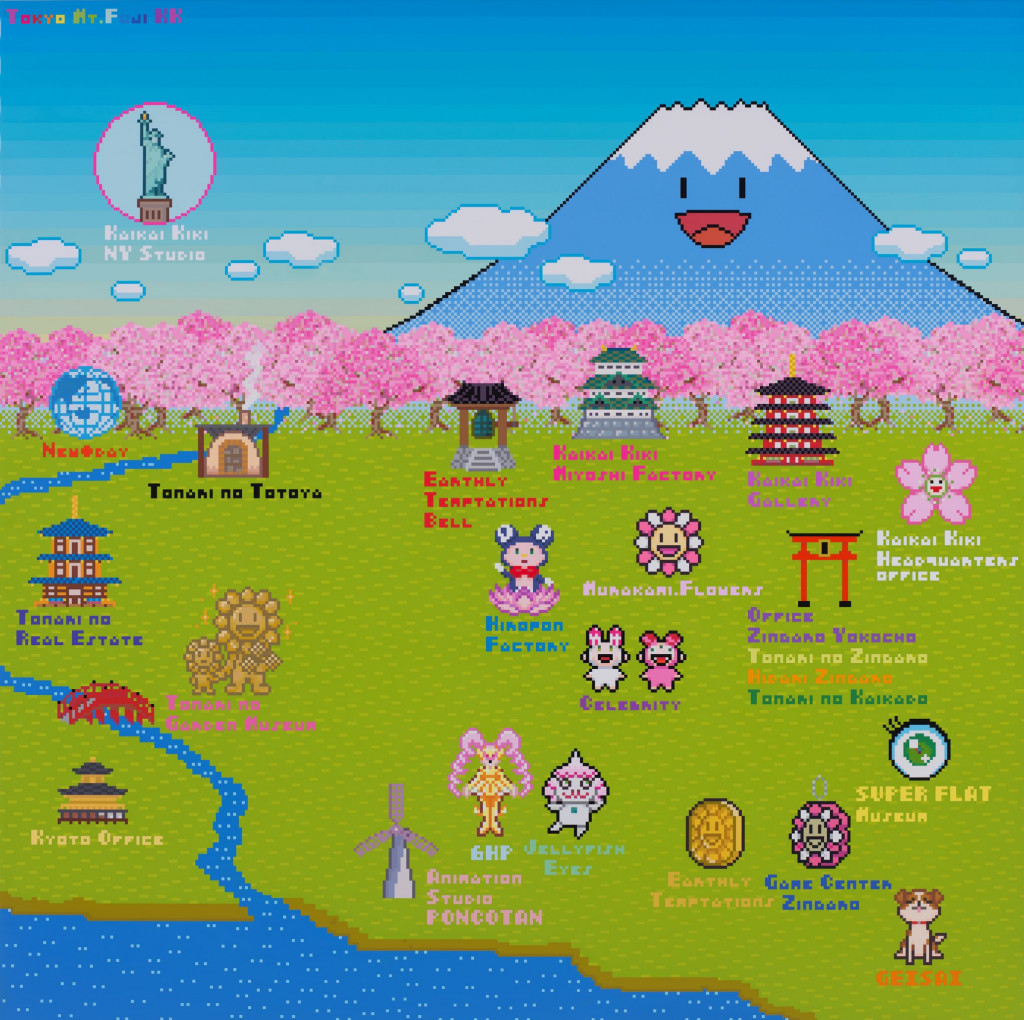
Murakami’s turn to NFTs is unsurprising, since his works already have the serialized quality of these digital artworks. He has offered editions of prints, posters, and collectible toys. The main difference is that on the NFT market, prices are set with the secondary market in sight: “That’s because in NFT art, unlike with the art of the offline world, everything is data,” he says. “I think whether or not an NFT work is completely consumed at that speed will determine its future valuation.” He is also not shy about his work’s engagement with commerce: he has said he is making art “to survive on the frontlines of the art market for over 30 years.”
Murakami’s sculptures look the way I imagine he wants the body to feel in digital space: slick, frictionless, and superpowered.
Murakami’s NFTs are a bid to posterity. A pixelated landscape on the far wall of the daisy room shows how the artist imagines his projects continuing after his death. As outlined on Twitter, this is a roadmap for the next phase of his practice, in which he aspires to bridge the worlds of contemporary art and NFTs. Murakami sees the metaverse as a kind of online brand universe, a “meta structure of my history as a painter,” as he recounts on the “Mind Map” section of the Murakami.flowers website. The green field is dotted with icons labeled after various parts of his practice, like “KaiKaiKiKi Gallery,” and “Superflat Museum,” but also just “Celebrity,” and “Earthly Temptations.”
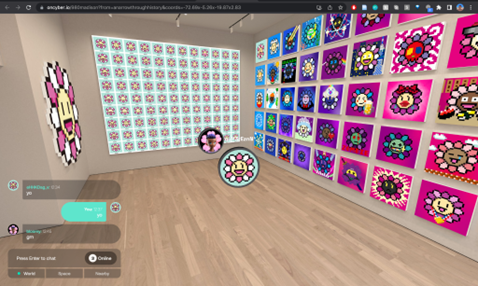
I opened a new tab to view the works at 976 Madison Ave. This site features Clone X (2021), Murakami’s collaborations with the NFT sneaker-art collective RTFKT. These avatars were developed online, as NFTs that Murakami owns (and does not intend to sell), which his studio meticulously re-created as paintings, then sanded down to look like screen prints. I can’t think of a better metaphor for capitalism than the hidden labor behind these works. Why not just screenprint? I’ve always waffled on Murakami, whose unironic engagement with the market feels apocalyptic and nihilistic, but whose earnestness captures the gluttonous death-drive of late capitalism. Few express this end-of-times spirit better.
As I pondered Murakami’s ambitions, I was feeling particularly disembodied. Recall that I am a small coin. I stood beside a shiny, elongated human figure titled Clone X × Takashi Murakami Avatar Hiropon Style (2022), one of several anime monuments. These sculptures look the way I imagine Murakami wants the body to feel in digital space: slick, frictionless, and superpowered. But as avatar 02EYat01Q I actually felt weak and unwieldy, a pawn with no way to break the rules.
At this point I noticed that three other people were online. Their coins hovered in the hallway to the second gallery. I did not move, and they floated past me. We did not speak, at least not in any substantive way. One’s name was eHHHKDag_v and after a minute they typed into the chat the salutation “yo.” Then someone named Bloomy typed “gm.” I didn’t know how to respond. I thought about typing “this is weird,” but I thought that might give myself away. Bloomy approached me and we stood facing each other. After some thinking I typed “AHHHHH” to see if someone might respond, but everyone had left the room. I was alone in the metaverse again.
Simon Wu is a writer and a curator with the Racial Imaginary Institute in New York.
